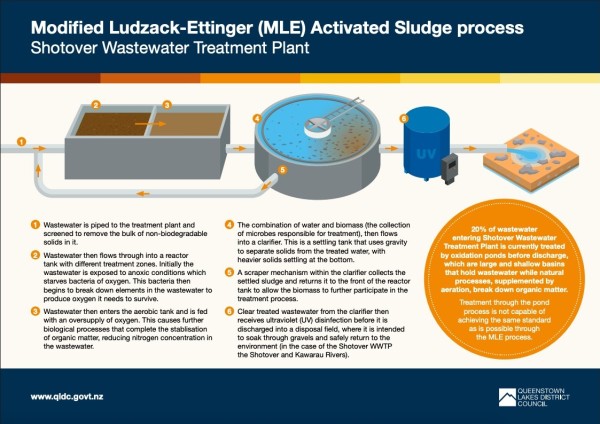Shaping our Community News Blog
Sewage in the Shotover? What’s happening with our wastewater infrastructure?
How do we ensure today’s problem doesn’t also become tomorrow’s problem?
As Queenstown continues to grow, the pressure on our infrastructure has never been more intense. My view is that we must take action to ensure we’re not just finding a fix for today but investing in solutions for tomorrow.
The story behind Project Shotover is one of difficult decisions, shifting priorities, and the need to balance affordability with long-term benefits.
The Origins and Challenges of Project Shotover
Back in 2009, major upgrades like Project Shotover (a multi-stage plan to upgrade and modernise our wastewater treatment) were considered crucial. However, the project became delayed and scaled back to avoid steep rate hikes for residents who were facing significant financial pressures post-GFC. Instead, a cheaper solution, the “dose and drain” disposal field was chosen based on growth projections that, at the time, seemed reasonable. In hindsight, these projections underestimated the rapid expansion that eventuated. As a result, the infrastructure hasn’t kept pace with the town’s rapid growth, and now, the community is facing serious environmental and compliance challenges.
The “dose and drain” land disposal system was designed to disperse treated wastewater through buried baskets and gravel, infiltrating into the ground. This seemed like a win for both the environment and ratepayers. But with growth, problems began to surface.
From late 2019, the disposal field began underperforming. Floods clogged the system with silty sands, reducing its ability to absorb treated wastewater. An independent study concluded that the design assumptions and size of the field were inadequate. Surface ponding and breakouts of treated water became common, raising concerns about contamination and bird-strike risks at the nearby airport.
In March 2025, QLDC invoked emergency powers to discharge treated wastewater directly into the Shotover River, the very practice the system was designed to avoid.
A retrospective consent application has been issued to the ORC, requesting public notification. We have also requested that the hearing be directed straight to the Environment Court, which has been agreed to by the ORC. This will ensure a trusted body which has knowledge of the issue while also maintaining public participation, at less cost.
Addressing the emergency and planning for the future
The council has taken several concrete steps to manage the current situation and restore public confidence. Here’s where things stand right now:
- Emergency discharge of treated wastewater into the Shotover River continues. Water quality testing continues and is monitored to ensure compliance.
- Consent limits range from annual averages, 95th percentile limits as well as absolute ceiling values. The type of consent limit depends on what is being measured. For example E-coli testing is referenced to an annual average and 95th percentile. This means that one individual test result cannot be used to test compliance, we require test results over 12 months for a check on compliance to be valid.
- Regular updates, transparent reporting, and opportunities for ratepayer feedback are being prioritised to keep the community informed and engaged.
You can keep up to date with this project, as well as see water test results and monitoring data on Council’s wastewater page.
All requests for information through LGOIMA on this topic have been proactively released and can be found here : https://www.qldc.govt.nz/your-council/lgoima-information-requests/proactive-releases-to-lgoima/

- Right now, we are working on the completion of our second treatment line, which is set to be up and running by December 2025.
- Once that’s done, the oxidation ponds are no longer required and will be removed, and a calamity storage facility will be built. This is to prevent non-treated wastewater from entering the environment in the event of a breakdown at the treatment plant.
- This $50 million investment—approved while I was Mayor—ensures we’re ready for growth in the basin until at least 2040.
Council has set aside $77.5 million over the next decade for a new disposal strategy that will ultimately replace the old field that’s been causing all the headaches, and bring us in line with the latest national environmental standards.
Health and longevity of our wider water infrastructure
The issue of wastewater treatment often raises questions around the performance of the rest of our district’s water infrastructure. We are all aware of the problems that Wellington City Council faced when decades of underinvestment by Wellington Water came back to bite them.
The good news is that our district’s water pipes are in remarkably good condition. On average, our underground assets have 75% of their useful life remaining, which puts us in a strong position for the future. This healthy state of our infrastructure hasn’t happened by accident; it’s the direct result of significant ongoing investment. In fact, much of the recent increases in rates—particularly over the last two years—have been driven by the need to fund depreciation on assets and manage the costs of maintaining and renewing these essential assets. By putting money aside for future repairs and replacements, we ensure that our water network doesn’t fall into disrepair, avoiding the kind of issues that have plagued other cities.
A recent report by the Infrastructure Commission suggests that at least 60 cents of every infrastructure dollar be spent on maintaining what we already have, rather than building new assets. That’s exactly the approach we are taking, while also accounting for future growth. While it means higher rates now, it’s a responsible strategy that prevents larger costs and disruptions down the track. By tackling maintenance and depreciation head-on, we are making sure Queenstown Lakes’ water pipes remain reliable, safe, and future-ready.
While the council is now investing heavily to correct past decisions, ratepayers deserve transparency and accountability. I encourage you to browse the Wastewater page on the QLDC website and understand the full story on our water infrastructure performance and investment.

